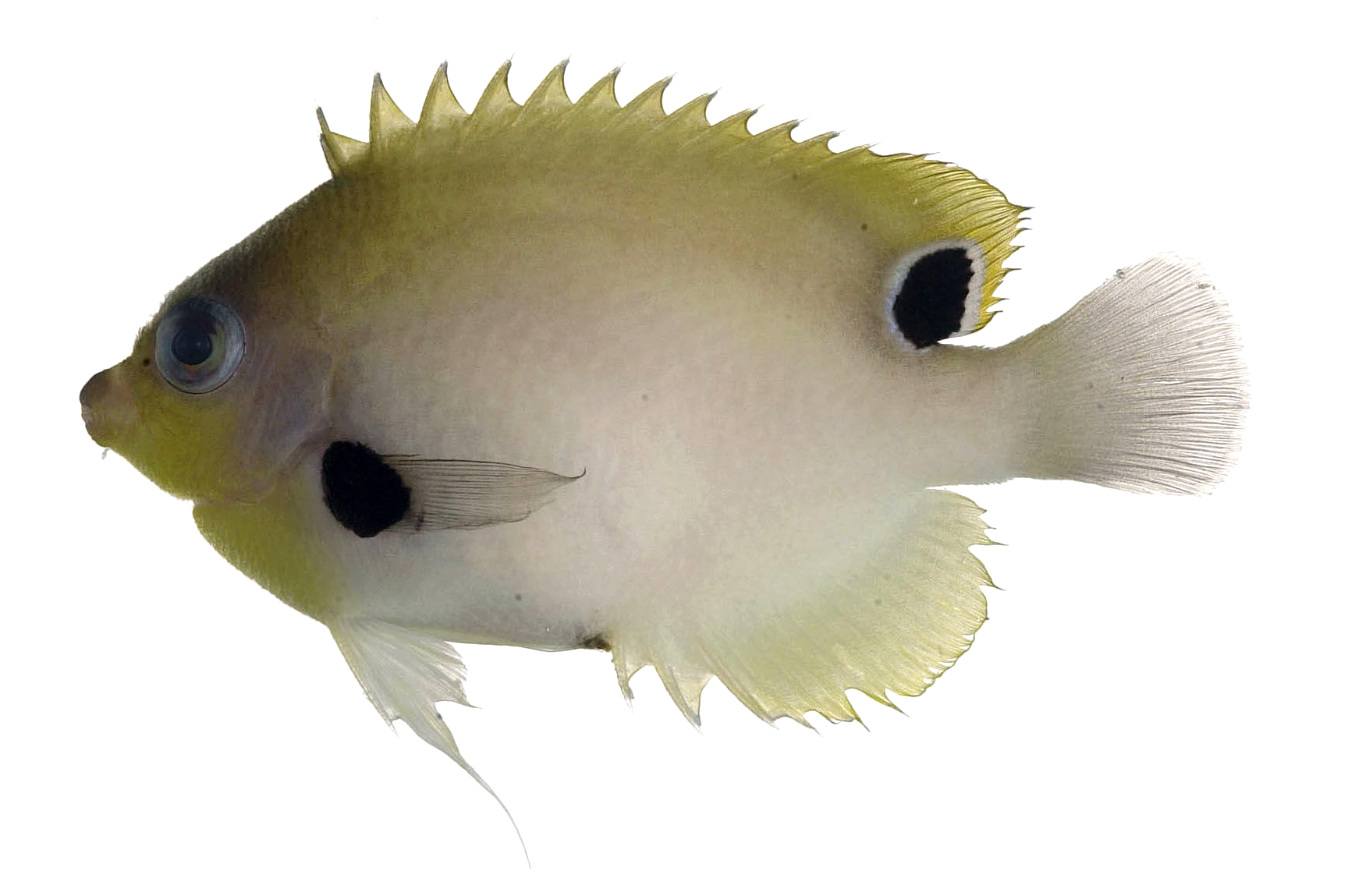- Classification
- ACTINOPTERYGII
- PERCIFORMES
- POMACANTHIDAE
- Centropyge
- nigriocellus
Blackspot Pygmy Angelfish, Centropyge nigriocellus Woods & Schultz 1953
Other Names: Blackspot Angelfish, Black-spot Angelfish, Black-spot Pygmy Angelfish, Ocellated Angelfish

A Blackspot Angelfish, Centropyge nigriocellus, from the Wallis Islands, French Polynesia - USNM 370570. Source: Jeffrey T. Williams / Smithsonian Institution, National Museum of Natural History, Department of Vertebrate Zoology, Division of Fishes. License: CC by Attribution-NonCommercial-ShareAlike
Summary:
A secretive pale yellow to whitish dwarf angelfish with a large black spot covering the pectoral-fin base and a black ocellus or false "eye-spot" on the rear of the dorsal fin.
Video of a Blackspot Angelfish from Holmes Reef in the Coral Sea, filmed in an aquarium at Cairns Marine.
A Blackspot Angelfish in an aquarium in Japan.
Video of a Blackspot Angelfish from Holmes Reef in the Coral Sea, filmed in an aquarium at Cairns Marine.
A Blackspot Angelfish in an aquarium in Japan.
Cite this page as:
Bray, D.J. 2022, Centropyge nigriocellus in Fishes of Australia, accessed 19 Apr 2024, https://fishesofaustralia.net.au/home/species/4944
Blackspot Pygmy Angelfish, Centropyge nigriocellus Woods & Schultz 1953
More Info
|
Distribution |
Holmes Reef in the Coral Sea (c. 16 28 S, 147 52 E). This rare species is known from scattered localities in the West-central Pacific including: Mariana Islands, Admiralty Islands, Johnston Atoll, Samoa, Line Islands, Society Islands (French Polynesia), Marquesas Islands, Papua New Guinea and the Cook Islands. Usually inhabits dead coral and rubble areas in clear lagoons and on outer reefs. |
|
Etymology |
The specific name nigriocellus is from the Latin niger (= black) and ocellus (= eye-like spot) 'in reference to the two black ocellate spots'. |
|
Species Citation |
Centropyge nigriocellus Woods & Schultz in Schultz et al. 1953, Bull. U. S. Natl Mus. 202(1): 607, Fig. 89. Type locality: Johnston Island, Northern Central Pacific, reef along northern side of atoll. |
|
Author |
Bray, D.J. 2022 |
|
Resources |
Blackspot Pygmy Angelfish, Centropyge nigriocellus Woods & Schultz 1953
References
Allen, G.R. 1980. Butterfly and Angelfishes of the World. New York : John Wiley & Sons Vol. 2 pp. 149-352 figs 214-510.
Allen, G.R. & Erdmann, M.V. 2012. Reef fishes of the East Indies. Perth : Tropical Reef Research 3 vols, 1260 pp.
Allen, G.R., Steene, R. & Allen, M. 1998. A Guide to Angelfishes & Butterflyfishes. Cairns : Odyssey Publishing/Tropical Reef Research 250 pp. figs.
Kuiter, R.H., Debelius, H. & Tanaka, H. 2003. Pomacanthidae, a Comprehensive Guide to Angelfishes. Melbourne : Zoonetics 206 pp.
Myers, R.F. 1999. Micronesian Reef Fishes. A comprehensive guide to the coral reef fishes of Micronesia. Guam : Coral Graphics vi 330 pp. 192 pls.
Pyle, R. 2001. Chaetodontidae, Pomacanthidae. pp. 3224-3286 in Carpenter, K.E. & Niem, V.H. (eds) The Living Marine Resources of the Western Central Pacific. FAO Species Identification Guide for Fisheries Purposes. Rome : FAO Vol. 5 2791-3379 pp.
Pyle, R. & Myers, R. 2010. Centropyge nigriocellus. The IUCN Red List of Threatened Species 2010: e.T165897A6159992. http://dx.doi.org/10.2305/IUCN.UK.2010-4.RLTS.T165897A6159992.en. Downloaded on 12 August 2016.
Randall, J.E. 2005. Reef and shore fishes of the South Pacific. New Caledonia to Tahiti and the Pitcairn Islands. Honolulu : University of Hawaii Press 707 pp.
Schindler, I. & Schneidewind, F. 2004. Revision of Centropyge fisheri (Snyder, 1904) (Teleostei, Pomacanthidae). Zeitschrift für Fischkunde 7(1): 31-42.
Woods, L.P. & Schultz, L.P. 1953. Subfamily Pomacanthinae. pp. 597-608, figs 88-89, pls 55B, C, 57B, 59 in Schultz, L.P., Herald, E.S., Lachner, E.A., Welander, A.D. & Woods, L.P. (eds). Fishes of the Marshall and Marianas Islands. Vol. 1. Families Asymmetrontidae through Siganidae. Bulletin of the United States National Museum 202(1): 1-685, figs 1-90, pls 1-74 https://doi.org/10.5479/si.03629236.202.1




